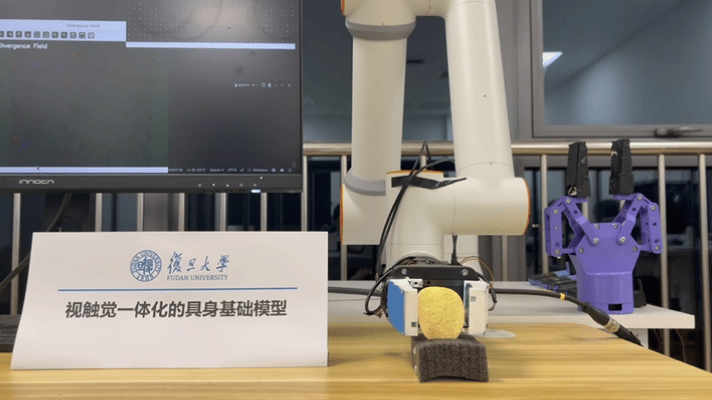
At the 2025 World Artificial Intelligence Conference (WAIC) held in Shanghai from July 26 to 28, a special invention appeared. It was an “adaptive vision-tactile AI sensor” made by the team from Fudan University’s Institute of Trustworthy Embodied Artificial Intelligence. This was the first time it was shown to the public.
This sensor acts like a “tactile gripper (触觉夹爪)” for robots. It can pick up fragile things such as tofu, potato chips and jelly very carefully. It feels the object’s surface, softness, hardness and how slippery it is. Then it lifts and puts down the object slowly without breaking it. Even more amazing, it can take tangyuan (glutinous rice balls) out of liquid. It watches where the tangyuan moves, catches the floating one with a spoon and moves it to another bowl.
How does it work? The sensor has special features: it is flexible, sensitive and has “tactile nerves”. It can feel different kinds of forces and uses both what it sees and AI to work. When it holds something, its soft surface fits the object’s shape, just like human skin. This stops it from crushing things, which hard grippers often do. It can feel forces from different directions, making sure it handles objects safely and skillfully.
Chen Wenming, a researcher from the institute, says the team wanted more than just feeling pressure in one direction. They wanted the robot to feel like human skin, which can sense pressure, sliding, twisting and other complex movements. Old tactile sensors could only feel simple pressure, but new robots need to feel in many ways, like our skin, to work better.
To make this happen, the team put a small camera inside the sensor’s tactile layer. When force is applied, tiny particles in the layer move, and the camera takes pictures of this. With AI, these pictures are turned into information about where and how much force is applied. This sensor is very sensitive, even more than human fingertips. It is also cheap to make, much cheaper than old “electronic skin”. In the future, it could be used in many areas, like making small parts, helping in surgeries and making better artificial hands.
原创编写 版权所有 侵权必究! 每日更新 个性化阅读 英语飙升!1.1.What ability of the robot is shown when handling objects?
A Using hands alone.
B Using eyes alone.
C Using hands and eyes.
D Using voice.
解析:选C。C 推理判断题。第二段描述机器人独立完成拿取汤圆等动作,从“picks up... feels the object’s... watches where... catches... moves”等细节可看出,机器人展现了手眼配合的能力。故选C。
2.2.What can we infer helps protect tofu?
A Hard outer part.
B Flexible surface.
C Large structure.
D Heavy weight.
解析:选B。B 推理判断题。第三段提到“柔软表面能贴合物体形状,避免压坏东西”,“flexible surface”与原文“soft surface”意思相近,可推断这是机器人的手能保护豆腐的原因。故选B。
3.3.What opinion may Chen Wenming hold?
A Old sensors work well.
B Robots need skin-like feeling.
C Simple pressure is sufficient.
D Complex movements are unnecessary.
解析:选B。B 细节理解题。第四段中的“They wanted the robot to feel like human skin, which can sense pressure, sliding, twisting and other complex movements.”陈文明表示希望机器人能像人类皮肤一样感知多种复杂动作。故选B。
4.4.How is the sensor according to the passage?
A Sensitive and low-cost.
B Slow and heavy.
C Expensive and weak.
D Large and rough.
解析:选A。A 细节理解题。第五段中的“This sensor is very sensitive...It is also cheap to make...”说明传感器很灵敏且制造成本低。故选A。